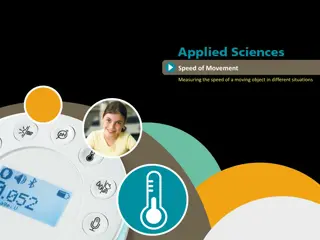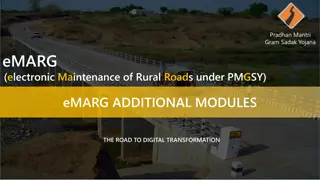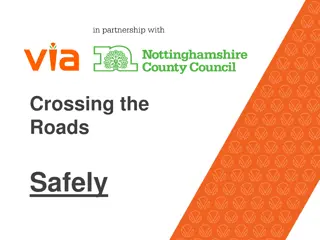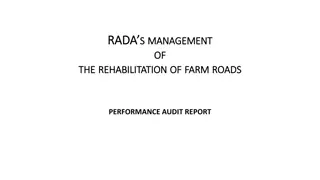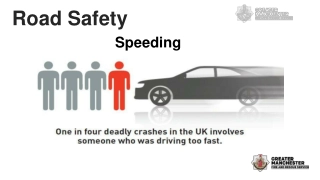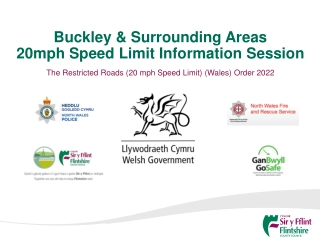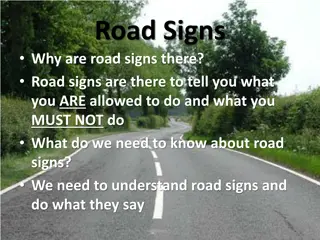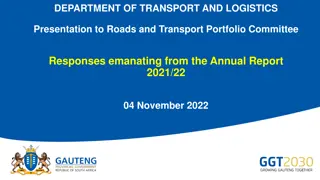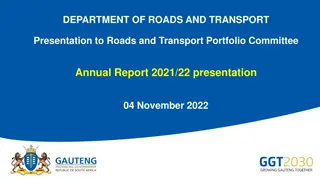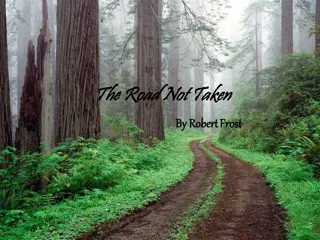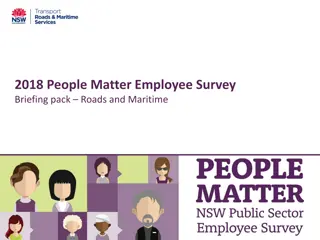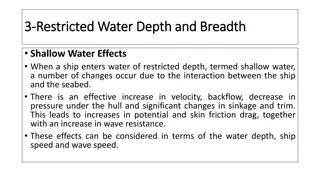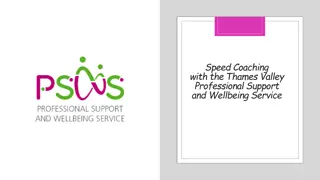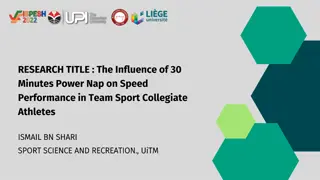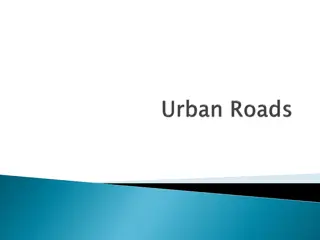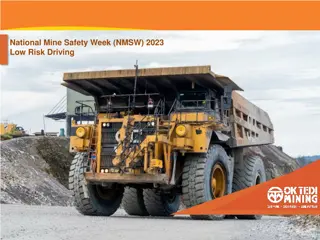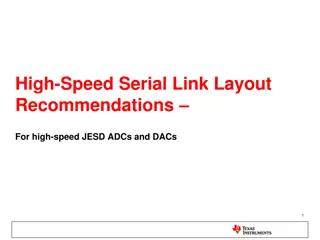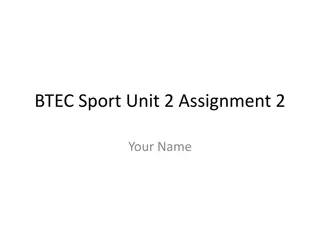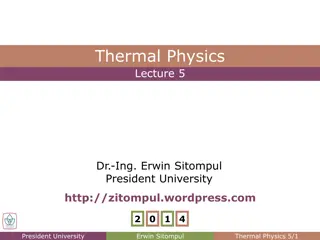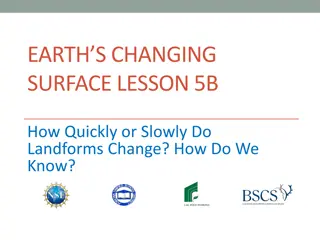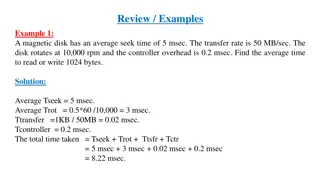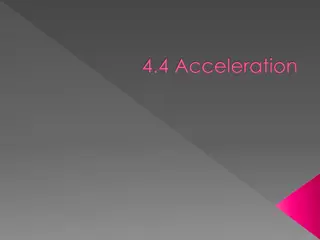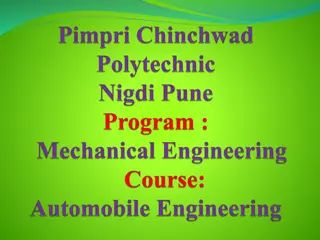Understanding Training on High-Speed Roads in the UK
This comprehensive program aims to assist driver trainers in helping learners and new drivers develop the necessary skills to navigate high-speed roads in the UK safely. Covering key areas like the high-speed network, risks, deregulation of motorways, essential competencies, and more, it is a valuable resource for both trainers and drivers. The initiative, delivered through DrivingHub, is supported by Highways England, road safety stakeholders, and government bodies, making it a collaborative effort towards enhancing road safety awareness.
Download Presentation

Please find below an Image/Link to download the presentation.
The content on the website is provided AS IS for your information and personal use only. It may not be sold, licensed, or shared on other websites without obtaining consent from the author. Download presentation by click this link. If you encounter any issues during the download, it is possible that the publisher has removed the file from their server.
E N D
Presentation Transcript
Training on high speed roads Part One - What? Who? Why? 2
What? This short programme has been created specifically to help driver trainers support learners and new drivers in the development of the necessary skills, knowledge and experience to safely manage the risks of using the high speed road network in the UK It covers: What is the high speed network? The key areas of risk in using the high speed road network in the UK What the deregulation of motorways means for trainers, pupils and drivers in general The key knowledge, skills and competencies required for Learners and New Drivers in this context Key research surrounding driver behaviour and attitude to driving on high speed roads Sample lesson plans for training sessions in this environment Key resources you can use to help in your delivery of training in this area o o o o o o o 3
The different types of high speed road Motorway Dual carriageway Single carriageway Rural 4
Who? Our overall educational campaign, delivered under the brand DrivingHub is primarily aimed at Learners, New Drivers, Driver Trainers and Parents/Guardians It has been produced via a collaborative partnership between Highways England and wider road safety stakeholder bodies and has the support of the Driving and Vehicle Standards Agency and Department for Transport The DrivingHub project is funded by Highways England and delivered by (and with the additional support) of The Driving Instructors Association 5
The wider high speed road network in the UK The UK has a road network totaling about 262,300 miles of paved roads. This breaks down into: 246,500 miles in Great Britain (England, Scotland and Wales) 15,800 miles in Northern Ireland This breaks down into: 2,173 miles (3,497 km) of motorways and 213,750 miles (344,000 km) of paved roads 6
What does the Highways England network cover? Watch this short video from Highways England first to get a sense of the length and breadth of one of the busiest road networks in the world! 7
Why are Highways England involved in this programme? New Driver Programme Highways England want to reduce the number of incidents and injuries on their network that currently stand at around 750m in costs associated with road traffic collisions and other incidents each year. By creating a new platform that is delivered by driving instructors to learner drivers to increase their awareness of the risks of driving on the Strategic Road Network (SRN), it provides driving instructors with a new set of tools to raise awareness and increase safety. 8
Why? Given the existing wide range of risks (and the resulting cost to life and the public purse of such risks) occurring on our high speed road network every day, a need has been identified to create specific educational resources and communications targeted at the next generation of network user so new drivers are more confident and competent in their use of high speed roads These educational resources (and accompanying communication campaigns) will also be targeted at the key influencers on our next generation users parents/guardians and driver trainers and hopefully, as a result of trying to make our Learners and New Drivers more savvy about using high speed roads, some of that knowledge will also transfer to those key influencers (existing licence holders) and improve their driving in this context too On June 4th 2018 Motorways were deregulated and restrictions lifted on provisional licence holders using them for training purposes, creating even more of a need for educational interventions now to ensure these new users are adequately prepared for training and driving in this context 9
Why do we need a New Driver Programme focused on high speed roads? To future proof the network To reduce incidents that can include casualties and fatalities on the network To encourage current users to get smarter (and safer) about network use To reduce over 750 million costs associated with Road Traffic Collisions and other incidents each year Deregulation of the motorway on 4th June 2018 Under the new plans, learner drivers would need to be: With an approved ADI Driving a car fitted with dual controls Branded car 10
Why? Risks and incidents occurring on the network 11
2016 Stats 19 - incidents on the network 101,158 Road traffic injury collisions 1.4% 22,400 16,233 10,158 Vehicles involved Resulting casualties Of all reported road casualties in GB 1.1% 0.8% 231 1,774 231 231 Killed Seriously injured KSI Slightly injured 3.1% 13.7% 12.4% 2.5% 12
2016 Stats 19 - incidents on the network The number of casualties involving a young motorist equates to one quarter of all casualties on the SRN 17% of the 2,005 KSI casualties involved in collisions recorded behaviour or inexperience as a contributory factor 13
2016 Stats 19 incidents on the network The following contributory factors relate to KSI casualties involving young motorists in 2016 on the SRN:- 18.1% 17.9% Failed to look properly Loss of control 14.3% 10.7% Failed to judge other person s path or speed Careless, reckless or in a hurry 14
Command & Control SRN Incident Data January to September 2016 26,904 Other 5,429 Running out of fuel 28,176 Tyre related Current and Future Non Injury Collision Data Sources 3,194 Obstruction due to straps Traffic Officer Command and Control 35,220 Debris/obstructi on 127,478 Breakdowns Motor Insurance Claims 5,122 Obstruction due to tyres 365 Wrong fuel 54,413 Other/unknown Utilise All Technology 52 Thrown objects 6,787 Illegal use of hard shoulder/ERA Vehicle Recovery Agents 160,097 Attended incidents 404,455 Logged incidents 2,860 Spillages 488 Oncoming vehicles 22,024 Non injury collisions 3,248 Animals on network 1,726 Fires 835 Suicide/attempt suicides Command and control data only recorded incidents that Highways England Traffic Officers had an awareness of or involvement in. Influenced by current patrol strategies that are predominantly motorway only. 15
Part Two The Research Driving on High Speed Roads: ADI and pupil perspectives 16
Our research We needed to know what should be included in a resource to help ADIs teach young people to drive on motorways, so this is what we did: Literature review Survey of 546 ADIs Survey of 93 novice drivers 2 ADI focus groups (North and South) 4 novice /pre-driver focus group (North and South) Further focus groups testing concept 83% of novice drivers drive on the motorway. Of these, 20% drive on motorways 5-7 times a week, 10% 3-4 times, 18% 1-2 times, 27% less than once a week, 20% less than once a month 17
Whats the problem with novice drivers? It is a fact that novice drivers have more crashes than experienced ones. These researchers have looked into factors that contribute to the causes with novice drivers. Novice drivers are less likely to notice hazards and are slower to respond to them (Crundall et al., 2012, 2016) Hazard perception skills increase with time but attitudes and behaviours become more risky (Roman et al., 2015 Impulsivity predicts aggressive driving, traffic offences and collisions (B c aks z and O zkan, 2016) 18
Whats the problem with novice drivers? Christmas (2007 2008) Young people think the Highway Code and the driving test are irrelevant to everyday driving: the relevance gap Young people use how safe they feel to judge their own competence: the measures gap Disincentives to spend longer learning to drive and no incentive for post-test improvement: the incentives gap Young people see no need for further training as they are confident in their own ability: the talent gap 19
What are some common issues with motorways? Poor experiences either as a driver or passenger Dislikes and anxieties of motorway driving Lack of, and/or, inaccurate levels of knowledge Risks 20
Poor experiences I was with my friend the first time she drove on a motorway and it was a nightmare because she didn t know anything about motorways and she thought the fast lane was to drive really fast. She was driving like a psycho and weaving into the fast lane whenever she got excited and going really fast and I was saying I don t think this is what you do. It s trying to predict what other people are going to do that is the hardest thing. It s scary, you re going so fast and you re just trying to watch what everyone is doing. On a motorway there s nowhere to go, like if you are driving on the roads and you get lost or something happens you can go and turn into another road and have a rest, whereas on the motorway there s kind of no escape. 21
Motorway dislikes Feeling pressured by other drivers (42%) Joining the motorway (38%) Driving in bad weather (26%) Feeling nervous on the motorway Not sure which way to go (44%) Broken down (55%) Losing concentration (29%) Joining a motorway (27%) Filtering between motorways (26%) Driving in bad weather (30%) Passengers distracting you (16%) Managing pressures from other drivers (34%) 22
Driver knowledge The meaning of a red X Which lane should you drive in When you can stop on the hard shoulder The meaning of variable speed limits How to plan a journey Making sure your vehicle is properly secured What should you do if your vehicle breaks down The meaning of different motorway signs Making sure your vehicle is safe to drive on the motorway What you should do in case of an incident or accident How to get the best fuel economy from your vehicle 4 23 2 1 3 0
Risky behaviour admitted in a survey Risky Behavior Never Occasionally Sometimes Fairly often Very often Switch between lanes in slow-moving traffic 20% 48% 21% 5% 6% Feel bored 30% 33% 29% 4% 4% Speed 43% 24% 15% 13% 5% Run low on fuel 46% 28% 16% 7% 4% Feel sleepy 38% 38% 18% 3% 3% Leaves less than 2 seconds between you and the car in front 49% 30% 9% 4% 8% Speak in a hands-free phone 51% 25% 13% 6% 5% Stay in the middle lane 51% 36% 5% 3% 5% Decide not to slow down in bad weather 62% 20% 7% 5% 6% Loose concentration 53% 29% 12% 3% 3% Overtake in the inside (undertake) 61% 21% 12% 4% 3% Decide not to slow down in roadworks 75% 12% 4% 3% 6% Use the internet 83% 8% 4% 0% 5% Use an app 87% 7% 1% 0% 5% Tailgate other drivers 80% 16% 1% 0% 3% Send or check phone messages 90% 5% 3% 0% 3% Speak on a handheld phone 80% 16% 1% 0% 3% Decide to ignore lane closure messages 93% 6% 1% 0% 0% 24
Current ways of learning: the ADI perspective Below are the areas ADIs say they cover both pre and post test and how likely they are do use these training methods: Before the test o o o o o Using dual carriageways (48%) Talking about the Highway Code (68%) Taking learners as a passenger on the motorway (11%) Recommending online (You Tube) videos (7%) E-learning (2%) After the test o o o o o Giving a practical lesson on the motorway (84%) Talking about the Highway Code (44%) Recommending online videos (4%) Running classroom sessions (2%) E-learning (1%) 25
Current ways of learning: ADI effectiveness Don t know Not at all effective Fairly effective Very effective Extremely effective In-car practical training 2% 2% 13% 34% 50% E-learning 35% 15% 39% 9% 2% Classroom lessons 31% 24% 35% 8% 2% Highway code 5% 17% 56% 16% 6% Online tutorial videos 40% 10% 37% 12% 1% E-learning currently very low as very little out there for trainers to use This e-learning gap will be filled by this project and hopefully we ll see that percentage increase 26
Current ways of learning: the driver perspective 50 40 30 Percent 20 10 0 I looked at the Highway Code I did some classroom learning I used a YouTube video I did some e-learning I haven t had any lessons or done any learning on this subject I had a motorway driving lesson with a driving instructor I asked a friend or relative to accompany me 27
Current ways of learning: what drivers want Definitely not Probably not Not sure Probably Definitely My driving instructor gives me e-learning demonstrations during my driving lessons 29% 18% 11% 28% 14% My instructor runs a classroom workshop for a group of learners 37% 26% 12% 20% 5% My instructor gives me advice on how to drive on the motorway during an in-car lesson 12% 6% 12% 33% 37% Before my test I practice driving on motorways with my instructor 22% 10% 9% 20% 39% After my test I will have motorway lessons with my instructor 14% 12% 8% 30% 36% 28
Challenges The literature review highlighted we focus too much on controlling the vehicle at the expense of higher-order cognitive skills (including anticipating hazards lower levels of the Goals for Driver Education Matrix (GDE)) ADIs are reluctant to be seen to waste time on higher-order skills during practical lessons, conscious of pupil s desire to be driving not thinking ADIs in the research would spend 5-10 minutes delivering the resource during lessons and think it unlikely that learners would use the resource out of lessons later focus groups where the actual concept materials were tested contradicted Challenges in getting ADIs to see e-learning resources as a benefit, rather than a threat/waste of time what about client centered learning, and not forgetting the National Standard for Driver and Rider Training Unit on Design Learning Programmes There will be challenges in overcoming beliefs that the best/only way of learning to drive on the motorway is a practical lesson 29
How can ADIs address the problems? The relevance gap: warn against bad habits: the driving test is relevant The measures gap: talk about the dangers of post-test driving: confidence increases faster than skill The incentives gap: warn that friends/family unlikely to have had any motorway training and pre- book motorway lessons The talent gap: talk about personality and the self-enhancement bias, and encourage CPD 30
Part Three Getting pupils and trainers up to speed 31
National Standards for Driver and Rider Training Unit 6.1 Prepare to Train Learner Driver/Riders meet all legal requirements Unit 6.2 Design Learning Programmes Unit 6 3 Enable Safe and Responsible Driving/Riding Unit 6 .4 Manage Risk to Instructor, Learner and Third Parties You can download the National Standards from GOV.UK Consider how these particular units apply to motorway (and other high speed road) training? 32
ADI Checklist Before commencing training on high speed roads, check: Are you able to offer motorway training? Can you access to motorways easily or how will you manage accessing them if further away? Are longer lesson periods to accommodate motorways outside your regular training patch even possible in your busy diary? Cost in extra lesson time, fuel costs, wear and tear properly and pricing appropriately Is your vehicle suitable and suitably maintained/prepared for training on high speed roads? Top box safe at speeds in excess of 70 mph? Vehicle clearly branded as an instructor car/pupil under supervision? Confident and competent? Are your skills, knowledge, competency and confidence up to training in this environment? Refresher and some additional training? Go out with a Diamond Trainer by contacting us at advancedmotoring.co.uk 33
Possible solutions/opportunities 2:1 Training take two pupils for one motorway training session, increases value of session for you and them (peer group learning, distraction experiences, car will handle differently etc)* Cost factor opportunity to upsell longer and more expensive sessions. Maybe a marketing hook for new pupils i.e. include as free session or cut price if pupils sign up to block training If you don t feel confident in delivering training in a high speed environment is this an opportunity to update skills and knowledge and invest in your continuous professional development (CPD) Advanced Driver Training when was the last time you undertook practical driver training for yourself/received feedback from other trainers? Train to deliver more of this nature of driving to a wider audience (i.e. FLH) than novices? Become a Diamond Trainer/Examiner * Ensure you seek permission from the pupils for a combined lesson and ground rules no phones and distraction by passenger, practicalities and planning of juggling two pupils and multiple pick ups and drop off, plus data protection 34
ADI Checklist Pupil Readiness Before taking individual pupils on high speed roads, check: Are you confident they are ready to tackle driving in this environment? Have they had a number of lessons already on other high speed roads, i.e. dual carriageways? Have they practiced joining, acclimatising, changing lanes, planning ahead and overtaking and exiting (our research identified these as areas of concern/ fear for pupils) What preparation/briefings have you given them about the distinct risks/challenges of motorway driving and how to manage them? Taking them through how to best plan that first motorway lesson so you get them thinking about having to plan every motorway journey in the same way Their checklist for motorway driving: Vehicle readiness Driver readiness Journey planning Breakdown equipment and know-how Traffic Weather Tracing and/or travelling alone letting others know where you are/your ETA/any issues 35
Key Competencies a recommended modular journey for your pupils Module 1 You, Your Vehicle, Your Journey This module covers: Distractions Alertness Vehicle Safety Checks Journey Route Planning 36
Key Competencies a recommended modular journey for your pupils Module 2 Driving on Rural Roads, Single and Dual Carriageways and Motorways This module covers: Road Types Driving Skills 37
Key Competencies a recommended modular journey for your pupils Module 3 Your Awareness and Driving Conditions This module covers: Your Awareness In Vehicle Driving conditions, Weather and Time of Day 38
Key Competencies a recommended modular journey for your pupils Module 4 Other Road Users This module covers: Vehicles that use the High Speed Network, including Vulnerable Road Users For example Blue Lights, Slow Moving Vehicles, Wide Loads LGVs 39
Key Competencies a recommended modular journey for your pupils Module 5 Breakdowns and Incidents This module covers: Breakdowns and Incidents Managing your own breakdown and incidents Driving around other breakdowns and incidents 40
Lesson Planning What would you do? The next two slides show example lesson plans for motorway training 41
Duration: Two Hours Course/topic: Introduction to Motorway Driving Aim: To introduce a learner or a novice (who has recently acquired a full licence) driver to motorway driving. Objective: At the end of the session the trainee will be able to carry out a range of manoeuvres on a motorway. Objectives/learning outcomes Prerequisite(s) National Standards Teacher/Trainer Activities Learner Activities Assessmen t Timing 20mins Drive to nearest motorway Unit 2.2 Agree levels of responsibility for session Drive as independently as possible, ask questions and respond to comments made by trainer Observation, Q&A Ready for practical test 30mins Unit 3.1, Elements 3.1.3 and 3.1.4 (a, c) Agree route to motorway with client and give feedback on trainee s driving Slip-roads, merging junctions Join a motorway for the first time Unit 3.1, Element 3.1.1 Complex junctions, dual- carriageways Lane Discipline Give prompts as necessary Units 2.3 (i, j), 4.2 Driving at motorway speeds National speed limit driving, rural roads, adequate clearance Use a variety of resources and teaching techniques to suit the client s learning style, learning preferences and standard of driving Unit 4.2 Forward scanning Hazard awareness Unit 3.1, Element 3.1.1(h) Overtaking Overtaking on dual-carriageways Leaving the motorway Unit 3.1, Element 3.1.4 (b, c) Leaving a dual- carriageway via a slip road 42
Duration: Two Hours Introduction to Motorway Driving Aim: To introduce a learner or a novice (who has recently acquired a full licence) driver to motorway driving. Objective: At the end of the session the trainee will be able to carry out a range of manoeuvres on a motorway. Timing Objectives/learning outcomes Prerequisite(s) National Standards Teacher/Trainer Activities Learner Activities Assessment 10mins Motorway Services, Resume Motorway Driving Car parks, Bay Parking Give prompts as necessary Drive as independently as possible, ask questions and respond to comments made by trainer Observation, Q&A Unit 2.2, Element 2.2.5 40mins Motorway Junctions Roundabouts, Slip- roads, Merging Junctions Use a variety of resources and teaching techniques to suit the client s learning style, learning preferences and standard of driving Unit 3, Element 3.1.4 (a, b, c, j) Managed, or Smart, Motorways Use of Speed, Adequate Clearance Unit 3, Element 3.1.4 (i) Incidents and when to stop on the hard shoulder Collision Procedures, Motorway Theory Unit 3, Element 3.1.4 (e.), Unit 4.3 Route Planning Unit 1.3 Fatigue, Boredom Hazard Awareness Unit 1, Element 1.1.2, Unit 3, Element 3.1.4 (l) Unit 2.2 Other Road Users 20mins Use of Speed Reflect on session, ask questions Self- reflective log Leave Motorway Network and Return Home Facilitate end of session de-brief 43
Learning Resources to support trainers, pupils and parents/guardians 44
Learning Resources underpinning the modules Interactive video and presentations Using existing network footage of risk incidents Interspliced with learning points, self reflection elements, quizzes Engaging and credible real life footage Usable by learners and trainers and in classroom (schools) Resource efficient using existing HE footage with low cost Quick quizzes Other resources Additional library of links and resources Get into Driving website can supply a lot of info to this National Standards Short bursts, voluntary and quizzes at end of each module to gauge whether learning on-boarded Multiple choice answers Reflective responses Surveys to gauge learning level and any additional learning needs 45
ADI Resources Overview of Pupil Resources Lesson Resources Walkthrough of pupil content Walkthrough the app Outline lesson plans for modules Lesson planning template Tips and techniques for delivering practical sessions Video and other useful resources 46
Parents/Guardians Overview Private Practice Resources Key risks of high speed roads The HE Network Legal aspects How parental/private practice helps Your role in private practice Walkthrough the app Parent/pupil agreement Outline private practice session Tips and techniques for delivering practical sessions Video other useful resources 47
Mobile app for all UK learners A smartphone app, distributed to all UK learners at zero cost, that enables them to develop a bespoke, broader, deeper learning experience and consequently reduces collision rates in the first year of driving post pass & reduce their insurance costs through better understanding of there risk profile. 48
Why should trainers and pupils use these resources? Free! Lots of useful tools and guidance Interactive content Encourages wider study outside of lessons Encourages self reflection and problem solving Forms good habits for future drivers Help us make the next generation of network user safer 49



